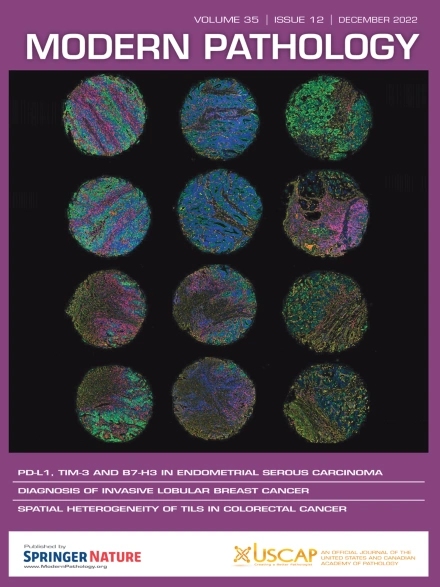Spatial Profiling of Ovarian Clear Cell Carcinoma Reveals Immune-Hot Features
IF 7.1
1区 医学
Q1 PATHOLOGY
引用次数: 0
Abstract
Ovarian clear cell carcinoma (OCCC) has a high incidence in Asia, with a frequent occurrence at an early stage, but without sufficient data on molecular stratification for high-risk patients. Recently, immune-hot features have been proposed as indicators of poor prognosis in early stage OCCC. Specific patterns of intratumoral heterogeneity associated with immune-hot features must be defined. NanoString Digital Spatial Profiling technology (Cold spring biotech corp.) was used to decipher the spatial distribution of the 18-plex protein panel. Regions of interest (ROIs) were collected based on the reference hematoxylin and eosin–stained morphology. Areas of illumination (AOIs) were defined according to the ROI segmentation using the fluorescence signals of the visualization markers pan-cytokeratin (PanCK), CD45, or DNA. Unsupervised hierarchical clustering of 595 AOIs from 407 ROIs showed that the PanCK segments expressed different combinations of immune markers, suggestive of immune mimicry. The following 3 immune-hot clusters were identified: granzyme B–high, immune signal-high , and immune-like cells; the following 2 immune-cold clusters were identified: fibronectin-high and immune checkpoint–high cells. In tumor samples at the International Federation of Gynecology and Obstetrics stage IC1/2 experiencing recurrence, there was an increased occurrence of PanCK+ AOIs with immune signal-high and immune-like cell groups in the papillary morphology surrounded by macrophage lineage tumor-infiltrating immune cells (TIIs). In contrast, for tumor samples at the International Federation of Gynecology and Obstetrics stage IC3/II with recurrence, PanCK+ AOIs were prevalent in the fibronectin-high group, particularly in those with a tubulocystic morphology surrounded by lymphoid lineage non-TIIs. Our study on the spatial profiling of early stage OCCC tumors revealed that the immune mimicry of tumor cells, presence of TIIs, and morphologic patterns were associated with recurrence, which switched during tumor progression.
卵巢透明细胞癌的空间谱分析揭示了免疫热点特征。
卵巢透明细胞癌(OCCC)在亚洲的发病率很高,常发生在早期阶段,但没有足够的数据对高危患者进行分子分层。最近,免疫热特征被认为是早期卵巢透明细胞癌预后不良的指标。必须明确与免疫热特征相关的瘤内异质性的具体模式。NanoString Digital Spatial Profiling技术用于解读18复合物蛋白质面板的空间分布。根据参考苏木精和伊红(H&E)染色形态收集 ROI。利用可视化标记泛角蛋白(PanCK)、CD45或DNA的荧光信号,根据ROI分割定义照明区域(AOI)。对来自 407 个 ROI 的 595 个 AOI 进行无监督分层聚类显示,PanCK 区段表达了不同的免疫标记物组合,表明存在免疫拟态。确定了三个免疫热簇:颗粒酶 B 高(GZMB)、免疫信号高(IH)和免疫样细胞(IL);确定了两个免疫冷簇:纤连蛋白高(FN)和免疫检查点高细胞(IC)。在复发的 FIGO IC1/2 期肿瘤样本中,PanCK+ AOIs 的发生率增加,IH 和 IL 组呈乳头状形态,周围有巨噬细胞系肿瘤浸润免疫细胞(TIIs)。相反,对于 FIGO IC3/II 期复发的肿瘤样本,PanCK + AOIs 在 FN 组中很普遍,尤其是那些形态为管状囊肿、周围有淋巴系非 TIIs 的样本。我们对早期 OCCC 肿瘤进行的空间图谱分析表明,肿瘤细胞的免疫拟态、TIIs 的存在和形态模式与复发有关,这些因素在肿瘤进展过程中会发生转换。
本文章由计算机程序翻译,如有差异,请以英文原文为准。
求助全文
约1分钟内获得全文
求助全文
来源期刊

Modern Pathology
医学-病理学
CiteScore
14.30
自引率
2.70%
发文量
174
审稿时长
18 days
期刊介绍:
Modern Pathology, an international journal under the ownership of The United States & Canadian Academy of Pathology (USCAP), serves as an authoritative platform for publishing top-tier clinical and translational research studies in pathology.
Original manuscripts are the primary focus of Modern Pathology, complemented by impactful editorials, reviews, and practice guidelines covering all facets of precision diagnostics in human pathology. The journal's scope includes advancements in molecular diagnostics and genomic classifications of diseases, breakthroughs in immune-oncology, computational science, applied bioinformatics, and digital pathology.
 求助内容:
求助内容: 应助结果提醒方式:
应助结果提醒方式:


